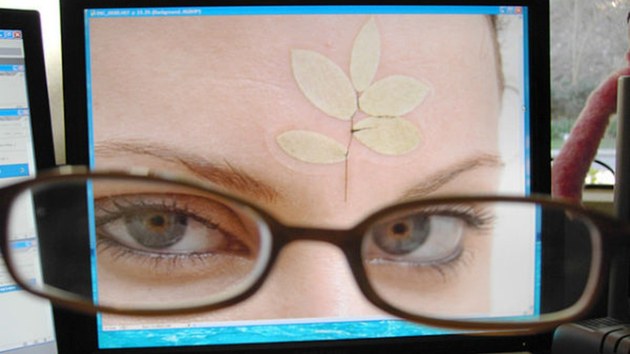How to Reduce Computer Eyestrain [and Potentially Boost Your Productivity]
The following compilation is a result of the collective experience of the many Internet freelancers, business coaches, tech nerds and doctors combined into a, hopefully, reader-friendly tutorial. We hope it helps you save your eyes from burning, your vision from blurring, your head from throbbing and your neck from aching.
Eyestrain is one of the many problems that significantly reduce productivity of people whose main working tool is computer/laptop. Besides eyestrain, or Computer Vision Syndrome, there are such things as Carpal Tunnel Syndrome and Repetitive Strain Injuries that are injuries to musculoskeletal and nervous systems caused by repetitive tasks, which in this case can be sustained or awkward positions. Like it or not, you have to do something about it before your sight and body starts failing you. So do yourself a favor and take care of your health.
Computer vision syndrome comes as a result of the wrong backlight of your monitor, glaring, staring at a screen for hours on end, and not giving yourself a break. Eye exercises and painkillers might relieve eyestrain for a while, but they are nothing but quick fixes and you can improve the situation if you adopt a preventive approach.
Your monitor’s position matters
Your eyestrain can be solved by a few simple tweaks to your monitor set up. For enhanced comfort and optimal positioning, your monitor should be 20 to 30 inches from your eyes, or 50 to 80 cm. Mind you that the top of the monitor should be approximately at the same level as your eyes and ideally you must be looking down at your monitor, not up.
Likewise, if your monitor is too low, consider using a couple of hardcover books to raise it up a bit.
Adjust the lighting
Too much artificial or too much natural light creates monitor glare that exhausts your eyes very quickly. In case you can, you must turn off harsh fluorescent lights and reposition your monitor so that as much as possible natural light is coming from either side of your monitor. By no means you should be positioned so that the light is directed behind or in front of your screen. Alternatively, you can use floor or desk lamps, positioning them on either side of your monitor for indirect lighting.
Get lazy or listen to your body
When you feel your focus is drifting away, it may be a sign that your body is getting tired. According to recent productivity research, people are most productive when they work as much as five hours a day and have short breaks every hour, plus 1 hour break in the middle. Check out this awesome article by David Brendel “The Heretic’s Guide to Getting More Done.” Surprisingly, researchers concluded that people who work less and grant themselves breaks, are more productive than people who work 9 to 5, six days a week. Unfortunately, few employers understand that by now. One way or another, if you can, make yourself a rule to give your eyes some rest every 20 minutes. Do some eye exercises while you reset your brain. Additionally, you can use automatic reminders to have these breaks with software like:
- EyeDefender
This application operates as many other eye relief web apps or break reminders, but since it’s a desktop application, it’s harder to get away from. It lives in your tray and counts down time to the next break. When it’s time for the break, there are four different eye resting activities you can choose from – doing some eye exercises, staring at pictures of your choice, activating the default screensaver or pop a balloon reminder, which only works for those with willpower. If you cannot go outside, we suggest you resort to visual training – as the screen darkens you must follow the display with your eyes and move them around a bit. It works like a charm and you can’t get back to work until the break is over. - Workrave
This one is a very neat open-source break reminder that covers reminders for micro-breaks, present breaks, which are longer and daily limits for computer time. You can customize the breaks the way you like and choose if you want to have the option to skip or snooze the break. It’s a mere window that reminds you about the break, but if it’s activated you won’t be able to use your computer until the break is over, or until you snooze, or skip the break. - Eyes Relax
This program works according to the same principle and offers a lot of customization options, as well as password protection and parental control features. For example, if you choose the Parent Mode, the computer is locked altogether, so that there is no way to escape the pause. Basically, you will force yourself to take the break. There are work, short and long breaks and notifications. You can make the application display the image or slideshow from your folders during the break, or set it to turn on the music at the time of the break. - Sunglasses [Chrome extension]
This is a very cute extension that enables you to control browser brightness separately from that of your computer. If at some point you realize that the brightness is just way too strong in Chrome, you can click the Sunglasses icon and choose a different brightness percentile to make your eyes feel more comfortable in a more soothing environment. - f.lux
This one is an excellent solution, which adapts your screen brightness to the time of the day, preventing eyestrain. You need to set your current location and the application will automatically define at what time the sun sets dimming your display at the right time every day. It’s a great way to relieve eyestrain between resting breaks.
Invest in a pair of computer readers
These are glasses with protective coatings on lenses designed to protect your eyes and lessen the destructive effect that the screen’s whites emit. In some cases, such glasses have a magnifying effect. They are not overly expensive and you can get a Foster Grant for as much as $30, or discover more high-end options, such as Gunnar Optiks, that offer awesome readers that are not only protective, but also very stylish and good-looking. Gunnar non-prescription models range from $60-$100.
Consider investing in Speech Recognition Software
Dragon Naturally Speaking can set you off a hefty $200, but once you master the tool, your eyes, hands, wrists, neck and shoulders get a significant relief while your productivity skyrockets because speaking is faster than typing.
Increase your browser display size
Nowadays most screens come in widescreen format, which does not adapt to some documents well, and sometimes browsers display websites in a column fashion way leaving wide empty margins on both sides. You can remove these margins by zooming in on the page. You can do so by holding down CTRL button and scrolling up with your mouse. You will see the text enlarge on your monitor, so scroll until the text fits your monitor nicely. If you are using Mac, you can increase browser window sizes by pressing Command and + several times.
Adjust desktop resolution and increase the windows and text size
You can adjust your home screen resolution to make your monitor display larger or smaller icons and the larger or smaller text depending on your preferences. In Windows, you can do so by right clicking on empty space in your desktop and selecting Screen Resolution. Likewise, you can go to Control Panel –> Appearance and Personalization –> Display. There, you will be able to see the suggestion to make it easier to read what’s on your screen. Besides the Magnifier tool, you will be able to adjust the size of text and other items on your screen between smaller, which is 100% by default, medium, which is 125% and large - 150%.
Go outside
It is advisable to regularly change different levels of light to kill the monotony of staring into the monitor all day long.
These steps can help you prevent the effects of long-term screen exposure from taking their toll on your health. They won’t prevent eyestrain altogether, but, combined, they will significantly save your eyes, so you can keep staring at screens for years to come. After all, you don’t want to be like that poor Thai freelance copywriter who died of a heart attack after she spent 30 hours working with no sleep, giving herself a Red Bull boost whenever her body wanted some rest.
What is your secret to saving your eyes and boosting your productivity? Share your thoughts in the comments below.



